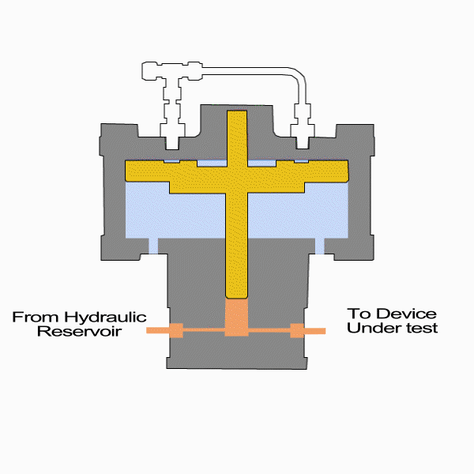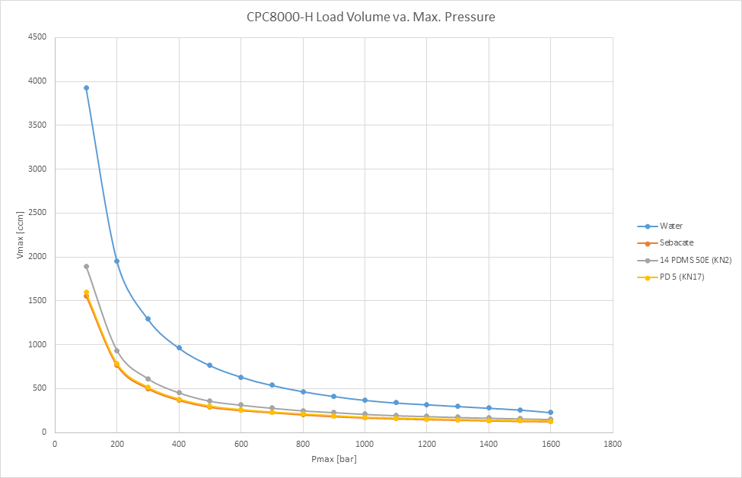Assuming you’ve read part 1 of this blog topic, it’s safe to say we’re all experts in the compressibility of different fluids. Now, let’s focus on some common media that are used in hydraulic applications throughout the process and calibration industry.
Because of their inertness, availability, and compression characteristics, oil and water are the most common fluids used in the field today. At low pressures (<1,000 psi), both media exhibit minimal compressibility, but as pressure rises, this compressibility becomes more apparent and critical to each application.

Figure 1: Pneumatic to Hydraulic Intensifier
Many hydraulic pressure controllers, like the CPC8000-H, use a pneumatic to hydraulic intensifier to derive high pressure output. This essentially takes a pneumatic control pressure applied to the top of the intensifier surface area and amplifies it proportionally to the bottom of the piston surface area (depicted in orange/red), on the hydraulic medium (see figure 1). The compressibility of the fluid plays a key role in the maximum output from the controller; the more compressible the fluid, the lower the pressure required to bottom out the piston stroke. As soon as the piston stroke reaches the bottom, it can no longer raise the pressure on the output.
In a working hydraulic system, the medium (water or oil) is usually stored in a tank and vented to atmosphere, where air can slowly diffuse into the medium. Additionally, the priming or pumping system can entrain air into the hydraulic fluid. Since the bulk modulus of air is so much lower than the hydraulic fluid, the overall result is lowering of the effective bulk modulus of the fluid, therefore, making it more compressible. There are many solutions to minimize the amount of air in the system, but any air in the system will need to be considered and it will limit the amount of total system volume a controller can achieve.
Even with a sufficiently purged medium, the total system volume will decay as the pressure rises. The graph below provides an example of projected maximum volume as the pressure is increased and compares these projections between some of the common hydraulic media used with the CPC8000-H for hydraulic high pressure calibrations.

What are the two common media options for pressure calibration?
Oil
Often the most favored and widely used hydraulic medium in process and calibration industries, oil has many beneficial properties. Oil is typically non-corrosive, has lubricating attributes, a wide temperature range, and is considered nearly incompressible in most applications.
Lubrication
One of oil’s most desirable features is that it will lubricate the system. Specifically, for pressure controllers in the calibration field, these lubricating properties provide tremendous benefit while a calibrator is maintaining pressure stability across the entire measurement chain. Any friction or non-responsiveness in the system can cause an unfavorable output, and using oil can help rid instability.
Temperature Range
Oil is thermally stable over a much wider temperature range than alternative hydraulic media. Having a higher boiling point and a much lower freezing point than water, oil can be used in a wide variety of applications. Many manufacturers will characterize their products by applying extremely low or high temperatures on their devices and oil is an ideal medium for these applications.
Incompressibility
While not as incompressible as water, machine oil still carries a strong bulk modulus, slightly under 200,000 psi. This incompressibility is one of the primary reasons oil is favored so heavily in hydraulic applications.
Non-corrosive
Along the same lines as its lubricating properties, oil is also non-corrosive to the system. As long as it is maintained to its operating ranges, and free of contamination, oil can be used and recycled for long periods of time without the need for frequent maintenance. This is extremely cost-saving to users by minimizing downtime of equipment and limiting repairs.
Water
Not always the most ideal because of its corrosive effects, water has many of the most optimal traits for hydraulic application. Water is clean, chemically inactive, widely available, and has a high bulk modulus (amongst liquids). This allows water to be used in a wide variety of applications.
Incompressibility
Having a bulk modulus of around 300,000 psi, water is one of the least compressible liquids available for hydraulic use. This allows water to achieve some of the highest pressures or volumes when using hydraulic systems. For example, the CPC8000-H can achieve its maximum pressure at a larger volume if water is the medium rather than an oil.
Chemically Inactive
Specifically for calibration labs, water provides immense flexibility for calibrations requiring high pressure hydraulic media. Because of water’s inert characteristics, users can be assured that there will not be any contamination introduced to the DUT and it provides no risk when the DUT is reinstalled into the process system.
Cleanliness
Unlike many other hydraulic media, water can be easily disposed of without risk of contamination. This is very unique to water, as it can be extremely costly to properly dispose of oil after usage. Along with being more environmentally friendly, water is also much easier to clean when leaks occur. Since purging the system is very common in hydraulic applications, cleaning can be a frequent nuisance if an oil-based medium is used.
Availability
Since it is the most abundant resource on the planet, it is no surprise that water is very available almost anywhere it is needed. This accessibility paired with the low cost provides added benefit to using this as a hydraulic medium.
Conclusion
Numerous types of media can be used in hydraulic pressure controllers. For the CPC8000-H Hydraulic Pressure Controller, many options are available such as water, Sebacate, Shell Tellus, Flourinert FC-770…the list goes on, but several things need to be considered when choosing the right medium for your application.
While considering all of the pros and cons of each medium, always keep in mind the amount of compressibility accompanying each fluid. Develop ways to purge the system of air to limit the amount of “wasted” volume that can get in the system. The Mensor service team is always available to assist and guide users through the proper purging techniques and optimal solutions for each application.
Related reading:


